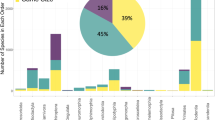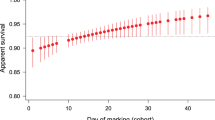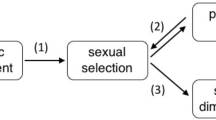Abstract
SEXUAL dimorphism in body size is widespread in the animal kingdom. Whereas male giantism has been studied and explained extensively1,2, male dwarfism has not. Yet it is neither rare3–7 nor without theoretical interest8,9. Here we provide experimental and comparative data on spiders to support the theory that dwarf males are associated with high differential adult mortality, with males at much greater risk. Species with sedentary (low-risk) females have dwarf, roving (high-risk) males. Life-history theory could readily explain dwarfing if juvenile, but not adult, male mortality were large. We present a new model in which high mortality of searching mature males reduces the adult sex ratio (males: females), relaxing male–male competition and reducing the importance of male body size to favour dwarfing by early maturation. Early maturity also reduces male juvenile mortality and thus opposes adult mortality. This provides a mechanism that buffers skews in adult sex ratio and which is quite distinct from Fisher's principle10 and allied mechanisms9,11 for the primary sex ratio.
This is a preview of subscription content, access via your institution
Access options
Subscribe to this journal
Receive 51 print issues and online access
$199.00 per year
only $3.90 per issue
Buy this article
- Purchase on Springer Link
- Instant access to full article PDF
Prices may be subject to local taxes which are calculated during checkout
Similar content being viewed by others
References
Cunningham, J. T. Sexual Dimorphism in the Animal Kingdom (Black, London, 1900).
Hendrick, A. V. & Temeles, E. J. Trends Ecol. Evol. 4, 136–139 (1989).
Gerhardt, U. Zool, Anz. 86, 80–82 (1930).
Elgar, M. A., Ghaffar, N. & Read, A. J. Zool. 222, 455–470 (1990).
Darwin, C. A. Monograph on the Cirripedia (Royal Society, London, 1851).
Kaestner, A. Invertebrate Zoology Vol. 2 (Wiley, New York, 1967).
Regan, C. T. Proc, R. Soc. B97, 386–399 (1925).
Darwin, C. The Descent of Man and Selection in Relation to Sex 2nd edn (Murray, London, 1894).
Ghiselin, M. T. The Economy of Nature and the Evolution of Sex (University of California Press. Berkeley, 1974).
Fisher, R. A. The Genetical Theory of Natural Selection (Oxford University Press. 1930).
Hamilton, W. D. Science 156, 477–488 (1967).
Vollrath, F. Z. Tierpsychol. 53, 61–78 (1980).
Pagel, M. D. & Harvey, P. H. Q. Rev. Biol. 63, 413–440 (1988).
Christenson, T. E. in Contemporary Issues in Comparative Psychology (ed. Dewsbury, D. A.) 149–174 (Sinaur, Sunderland, Massachusetts, 1990).
Vollrath, F. in Ecophysiology of Spiders (ed. Nentwig, W.) 357–370 (Springer, Berlin, 1987).
Newman, J. A. & Elgar, M. A. Am. Nat. 138, 1372–1395 (1991).
Gertsch, W. J. American Spiders (Van Nostrad, New York, 1949).
Levi, H. W. J. New York ent. Soc. 58, 59–91 (1955).
Watson, P. J. Behavl Ecol. Sociobiol. 26, 77–90 (1990).
Gunnarson, B. J. Zool. 217, 1–7 (1989).
Clutton-Brock, T. The Evolution of Parental Care (Princeton University Press, 1991).
Emlen, S. T. & Oring, L. W. Science 197, 215–223 (1977).
Parker, G. A. J. Fish. Biol. (in the press).
Maynard Smith, J. Evolution and the Theory of Games (Cambridge University Press, 1982).
Clutton-Brock, T. & Parker, G. A. Q. Rev. Biol. (in the press).
Smith, G. Fauna Flora Golf. Neapel 29, 1–123 (1906).
Caullery, M. Mitt. zool. Stn Neapel 18, 583–643 (1908).
Bertelsen, E. Dana Rep. 39, 1–176 (1951).
Beebe, W. Zoologica 6, 149–241 (1934).
Lockett, G. H. & Millidge, A. F. British Spiders Vol. 1 (Royal Society, London, 1951).
Lockett, G. H. & Millindge, A. F. British Spiders (Royal Society, London, 1953).
Shinkai, E. & Takano, S. Spiders of Japan (Tokai University Press, 1984).
Koh, J. K. H. A Guide to Common Singapore Spiders (Singapore Science Centre, 1989).
Mascord, R. Australian Spiders (Reed, Wellington, New Zealand, 1970).
Author information
Authors and Affiliations
Rights and permissions
About this article
Cite this article
Vollrath, F., Parker, G. Sexual dimorphism and distorted sex ratios in spiders. Nature 360, 156–159 (1992). https://doi.org/10.1038/360156a0
Received:
Accepted:
Issue Date:
DOI: https://doi.org/10.1038/360156a0
This article is cited by
-
The effect of genetics, diet, and social environment on adult male size in a sexually dimorphic spider
Evolutionary Ecology (2021)
-
Ecophysiological determinants of sexual size dimorphism: integrating growth trajectories, environmental conditions, and metabolic rates
Oecologia (2019)
-
A synthesis of major environmental-body size clines of the sexes within arthropod species
Oecologia (2019)
-
Coevolution of female and male genital components to avoid genital size mismatches in sexually dimorphic spiders
BMC Evolutionary Biology (2016)
-
Selection for predation, not female fecundity, explains sexual size dimorphism in the orchid mantises
Scientific Reports (2016)
Comments
By submitting a comment you agree to abide by our Terms and Community Guidelines. If you find something abusive or that does not comply with our terms or guidelines please flag it as inappropriate.



